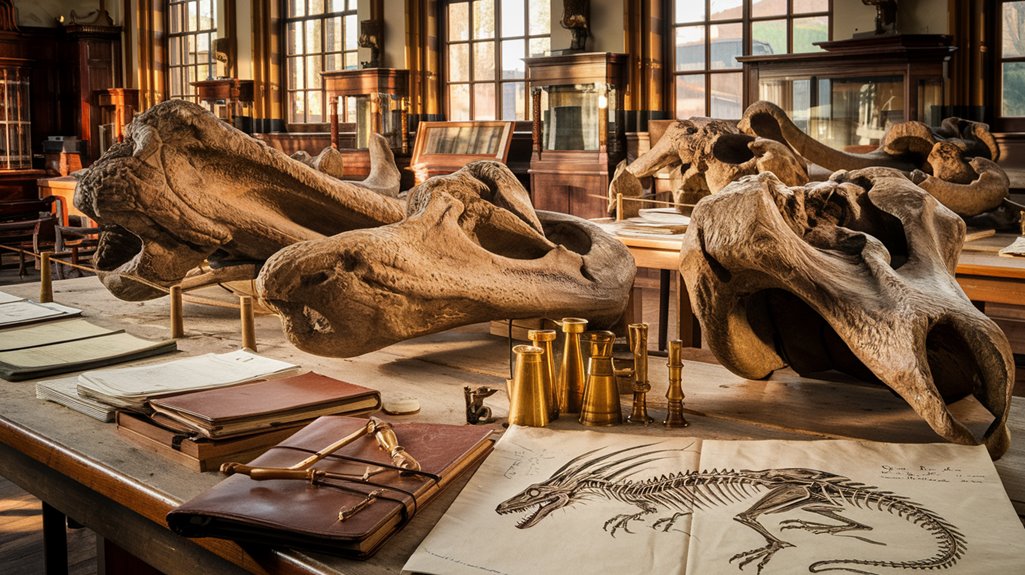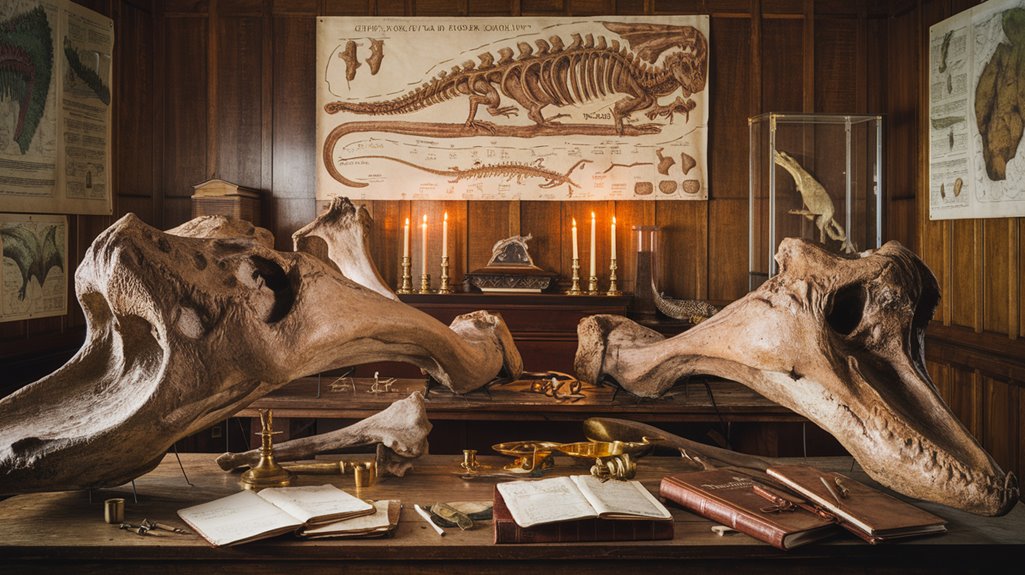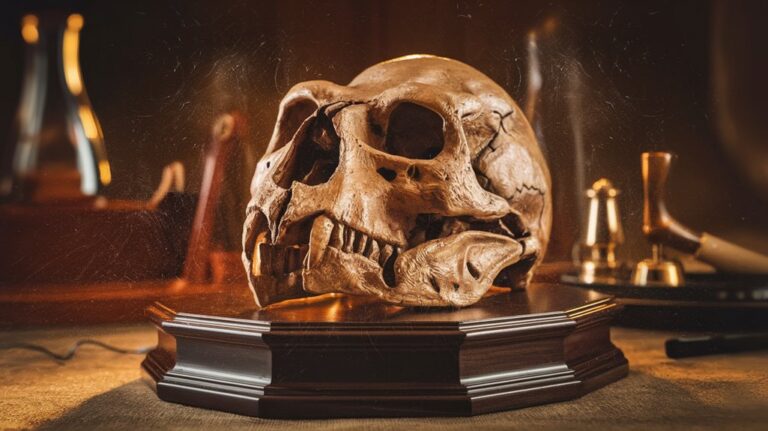Dino Discoveries: Early Theories Involving Giants or Dragons
While today you can identify a T-Rex skeleton with ease, our ancestors faced these same bones with wonder and wild speculation. They didn't have the scientific framework to understand fossilized remains, so they created elaborate stories of dragons and giants to explain what they'd found. You'll discover how ancient civilizations from China to Greece interpreted these mysterious artifacts, and how their creative explanations shaped both cultural mythology and the early foundations of paleontology.
Ancient Interpretations of Mysterious Bones
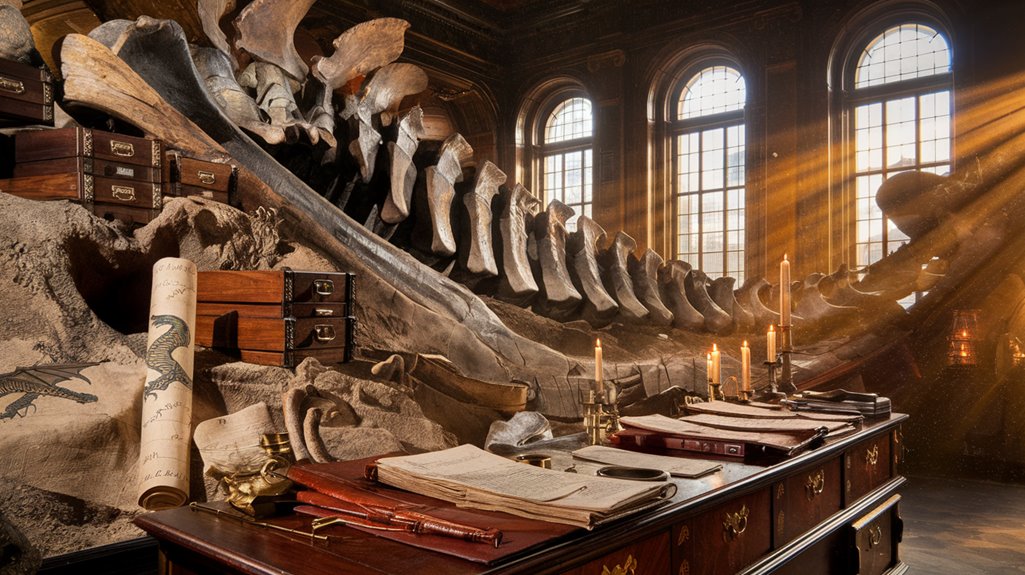
When ancient civilizations first encountered mysterious fossil bones, they made sense of these discoveries through the lens of their cultural beliefs and mythology.
You'll find examples of how ancient fossils influenced legendary creatures, like the massive elephant skulls with their central nasal cavity that were interpreted as evidence of one-eyed giants or Cyclopes.
In China, the discovery of long-necked sauropod remains likely sparked tales of dragons, while in other regions, cultural beliefs led people to view fossils as proof of biblical events like the great flood.
The way these ancient civilizations interpreted fossils wasn't random – they carefully collected, measured, and documented their findings.
These early attempts to understand prehistoric remains, though scientifically inaccurate, laid the groundwork for modern paleontology. Tales of such discoveries spread along ancient trade routes and influenced the development of various mythological creatures. Today, scientists know that these mysterious bones came from creatures that inhabited Earth for 245 million years before going extinct.
The Dragon-Dinosaur Connection
Throughout history, the striking similarities between dragon myths and dinosaur fossils have captivated both scientists and folklore enthusiasts.
When you examine ancient civilizations' encounters with mysterious bones, you'll find they often interpreted these remains as evidence of dragons, especially in China where dinosaur fossils were explicitly labeled as dragon bones.
You'll notice that dragon symbolism across cultures shares remarkable parallels with dinosaur fossils: both feature massive size, reptilian scales, and serpentine characteristics. Early fossils discovered in regions like Brazil and Argentina show that these creatures first emerged in hot equatorial areas.
While there's no scientific evidence proving dragons existed, the connection between these mythical creatures and actual prehistoric remains isn't coincidental.
Ancient peoples discovered giant bones they couldn't explain, leading them to create stories that matched their findings. These interpretations evolved into the rich dragon lore that continues to fascinate us today. Modern scientists recognize that prehistoric mammals were often much larger than their present-day relatives.
From Mythical Giants to Scientific Reality
Before modern science revealed the true nature of fossils, ancient civilizations viewed these mysterious remains through a lens of mythology and wonder.
You'll find that giant myths and fossil legends dominated early interpretations, with cultures worldwide believing these bones belonged to dragons, giants, or mythical creatures.
When you look at how this understanding evolved, you'll see a fascinating transformation during the Renaissance. Early reconstructions like the Quedlinberg Unicorn demonstrated this blend of mythology and attempts at scientific interpretation.
These massive fossils sparked such fantastical theories in part because their unique hollow bones, similar to modern birds, made them seem impossibly large to early discoverers.
Scientists like Nikolaus Steno began challenging these ancient beliefs, paving the way for modern paleontology.
The shift from mythological explanations to scientific understanding wasn't immediate – even until 1842, people were still using the term "dragon" for what we now call dinosaurs.
Today, you can appreciate how theories like Cope's Rule and our knowledge of ancient environmental factors explain these prehistoric giants that once sparked our ancestors' imaginations.
Early Scientific Illustrations and Their Impact
The earliest artistic depictions of prehistoric life emerged long before formal scientific study, from Indigenous rock art to medieval dragon myths.
You can trace this legacy through 600-year-old rock art in Utah, where ancient artists recorded what they believed to be thunderbird tracks – now known to be dinosaur footprints.
Early depictions often helped establish prehistoric myths, with artists like Philipp Johann Strahlenberg illustrating ancient mammoth discoveries.
Scientific accuracy took a leap forward in the 17th and 18th centuries, as increased global travel sparked new fossil discoveries. Richard Owen introduced the term "dinosaur" in 1841, marking a pivotal moment in paleontological history.
The artistic evolution of these prehistoric creatures is evident in Johann Hermann's groundbreaking Pterodactylus illustration and Henry De la Beche's Duria Antiquior, which portrayed entire Jurassic ecosystems.
The Renaissance Shift in Fossil Understanding
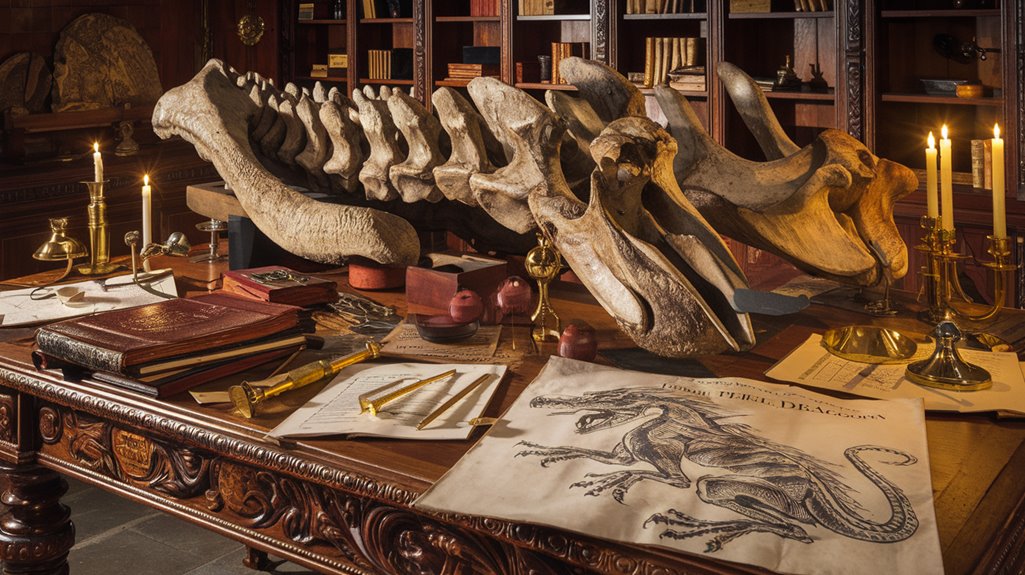
Renaissance minds sparked a revolutionary change in how we comprehend fossils, moving beyond medieval myths and superstitions.
You'll find that pioneering thinkers like Leonardo da Vinci and Nicholas Steno revolutionized fossil classification through careful observation and analysis of geological evidence.
Their groundbreaking work established that fossils weren't mystical formations but actual remains of ancient life. Ancient cultures often incorporated these mysterious remains into their mythological belief systems. Ancient European scholars frequently misinterpreted dinosaur bones as proof of Biblical giants that once roamed the Earth.
Here's what made their discoveries so significant:
- Da Vinci's examination of marine fossils in mountains challenged biblical flood theories
- Steno's identification of shark teeth transformed scientific understanding
- Cuvier's comparative anatomy work proved extinction was real
- Aldrovandi's systematic fossil classification laid groundwork for modern paleontology
This shift in thinking paved the way for future evolutionary theories and helped establish paleontology as a legitimate scientific discipline.
Bridging Mythology and Modern Paleontology
Ancient civilizations' interpretations of mysterious fossil remains bridged an intriguing gap between mythology and modern paleontology. You'll find that fossil folklore shaped many cultural narratives, as early Greeks and Romans studied bones they couldn't fully explain.
 Central Asian regions sparked extensive mythological discussions.
Central Asian regions sparked extensive mythological discussions.
However, you shouldn't assume all ancient myths were based on fossil evidence. Modern research shows that some popular connections, like the link between Protoceratops fossils and griffin legends, aren't as compelling as once thought. A recent study in Interdisciplinary Science Reviews disproves this three-decade-old theory.
When examining these historical interpretations, it's essential to separate fact from speculation and ground your analysis in both historical context and paleontological evidence.

